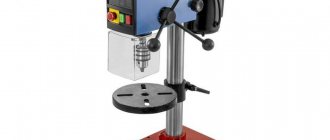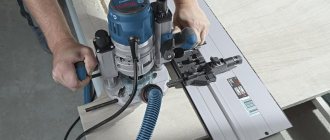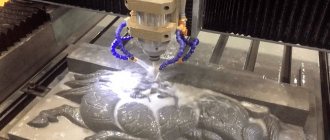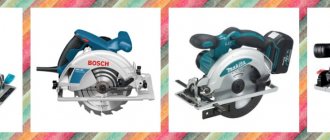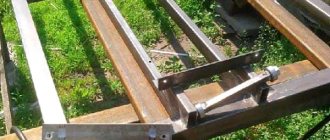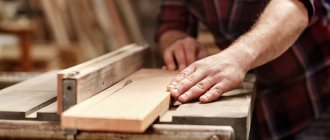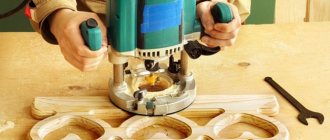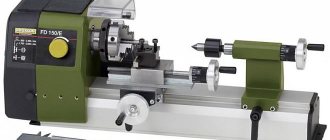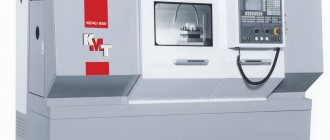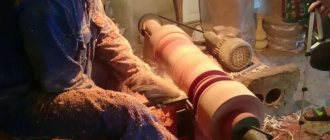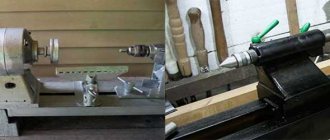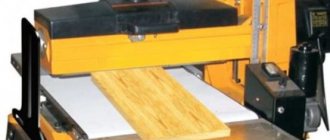For any work to be successful, you must have good equipment and tools. The same statement applies to amateurs (or professionals) “tinkering” with wood. Craftsmen who make furniture or other wooden products always try to acquire various tools and devices that can help them in their work.
For example, a jointer. This device significantly increases the productivity and quality of woodworking. But not all fans can purchase it, because its price is quite high. How to get out of such a difficult situation? There is a solution, and it’s quite simple - it’s to make a tabletop jointer with your own hands. And the manufacturing process itself will be discussed in the article.
Rating of budget planer-thicknessing machines
Belmash JT-2 204/210 S091A
This is a reliable device with a power of 1500 W and a planing shaft diameter of 51 mm. The product is perfect for installation in a home workshop. It is powered by 220 V. The model has 2 well-sharpened knives. Transmission - belt. The maximum planing depth is 2 mm.
The length of the working table (jointer) is 737 mm, for a surface planer this value is 285 mm. Product weight – 29 kg, installation method – floor. Small dimensions make it possible to install the product anywhere. The type of frame used is prefabricated. The rotation speed reaches 9000 rpm. There is also a rip fence, which is made of aluminum.
The average cost is 23,990 rubles.
Belmash JT-2 204/210 S091A machine
Advantages:
- floor version;
- sawdust and dust are removed through a removable casing;
- high assembly reliability;
- automatic feeding;
- knife shaft diameter – 51 mm;
- excellent performance.
Flaws:
BISON MASTER SRF-254-1600S
This is a Russian version that allows you to process plywood using the planing method. The machine is easy to operate: changing operations takes a couple of minutes. The main feature of the model is that it does not require constant maintenance.
To ensure that the product lasts as long as possible, the manufacturer equipped it with a belt drive. The model has an electric motor with overload protection. Power consumption – 1600 W. There are 2 cutting elements made of durable material.
The part is fed automatically. The operating speed is 6 meters per minute, which is the optimal solution for home use.
machine BISON MASTER SRF-254-1600S
Advantages:
- economical engine;
- overload protection;
- optimal dimensions of the working surface;
- automatic feeding;
- stand included;
- adjusting the guide angle.
Flaws:
Enkor Corvette-26 90260
This is a convenient model that will help you carry out processing quickly and efficiently. It is suitable for small construction or small-scale production. The equipment is capable of performing 2 functions:
- Planing.
- Reismus.
The transition from one operation to another takes a minimum of time. The device does not require special maintenance. To keep the workspace clean, there is a pipe at the bottom to which the bag is attached.
Sawdust and dust come inside, which allows you not to be distracted by cleaning. The commutator motor has high-quality protection against overheating, so the operator can use the product for a long period without worrying about overheating of the power unit.
machine Enkor Corvette-26 90260
Advantages:
- extensive functionality;
- ease of operation;
- high accuracy;
- operational safety;
- cleanliness during processing;
- motor with overheating protection;
- quick transition between modes.
Flaws:
STAVR SDSR-2/1700
This is a budget model that is intended for home use. The maximum thickness of chips removed is 3 mm. Equipment power – 1700 W. Shaft rotation speed – 9000 rpm. The weight of the structure is 27.5 kg, which allows you to easily move the device from one place to another. The permissible workpiece height is 120 mm. The device is equipped with a high-quality engine, which ensures high performance and safe performance of various works.
machine STAVR SDSR-2/1700
Advantages:
- low cost;
- durability;
- high efficiency;
- convenient control;
- high-quality assembly;
- high assembly reliability;
- light weight.
Flaws:
Models
When choosing equipment, you need to take into account the size of the workpiece and the volume of work performed. If you plan to process small bars, you can purchase a compact model with a power of 4 kW. For large lumber, you will need a larger unit with a high-performance engine.
Joining machines "Kraton"
Model Kraton WMPT-260 (39,300 rubles) performs jointing and thicknessing, has a power of 1500 W, is compact, and is equipped with automatic feeding of workpieces.
Jointer JET
Combined machines JET JPT-10B (34,000 rubles) with a power of 1.5 kW are distinguished by their small dimensions and the ability to extend the working surface.
JET JPT-310 machines (80,000 rubles) have a power of 5 kW and are distinguished by double motor insulation. It is possible to connect a vacuum cleaner.
The JET Jointer 6'' jointing machine (193,000 rubles) with a capacity of 3.5 kW is equipped with a shaft with 48 knives. This is equipment for jointing and thicknessing.
SF-4 machines
The single-sided jointing unit SF-4 (179,000 rubles) has a two-knife round shaft that makes 5000 rpm. The machine is equipped with a three-phase squirrel-cage asynchronous electric motor.
Holzstar ADH 305 machine
A tabletop planer-thicknesser unit with a power of 1.8 kW is equipped with two knives and a rubber-coated output shaft. The average price is 44,900 rubles.
Brand Corvette
Series 106 (29,960 rubles) with a power of 1.5 kW is equipped with special pushers and a shaft with three knives.
The Enkor Corvette-24 sample (18,130 rubles) has a power of 1.25 kW and allows you to quickly switch planing from thicknessing to jointing mode.
Machines MB5026
The single-sided model MB5026 (54,900 rubles) made in China is equipped with a shaft with three cutters and has a power of 3 kW.
Brand Scheppach
Planer-thicknesser machines Scheppach HT-1050 (23,000 rubles) with a power of 1.5 kW and a productivity of 9000 rpm demonstrate reliable operation and clean processing of lumber.
The Scheppach HT-850 sample (17,000 rubles) of combined action with a 1.25 kW motor is compact and allows for a smooth surface of the workpiece.
The HT-650 jointer (18,020 rubles) is equipped with a 1.28 kW engine, has a mobile design, and provides for manual feeding of lumber.
| Manufacturer | Model | Power, W | Average price, rub |
| Kraton | WMPT-260 | 1500 | 39 300 |
| JET | JPT-10B | 1500 | 34 000 |
| JPT-310 | 5000 | 80 000 | |
| Jointer 6'' | 3500 | 193 000 | |
| Kurgan plant of woodworking machines | SF-4 | 2800 | 179 000 |
| Holzstar | ADH 305 | 1800 | 44 900 |
| Corvette | 106 | 1500 | 29 960 |
| Enkor Corvette-24 | 1250 | 18 130 | |
| — | MB5026 | 3000 | 54 900 |
| Scheppach | HT-1050 | 1500 | 23 000 |
| HT-850 | 1250 | 17 000 | |
| HT-650 | 1280 | 18 020 | |
| Makita | 2012NB | 1650 | 41 000 |
| DeWalt | D27300 | 1600 | 78 900 |
The price of Makita and DeWalt machines depends on the type of device and its configuration. The Makita 2012NB planer-thicknesser has a power of 1.65 kW, the price is about 41,000 rubles. The DeWalt D27300 machine with a power of 1600 W costs 78,900 rubles.
Video review of the Enkor Corvette-24 jointer.
Don't miss the fundamental difference between similar processes
Several passes of piece lumber with broken geometry on the planer table make it possible to obtain a right angle of adjacent surfaces of the workpiece. And the resulting planes will be used as a basis for further calibration. That is, by passing planed lumber through a planer, you get perfectly smooth parallel surfaces and a right angle along the entire length of the board or beam.
The interchangeability of these processing steps is excluded:
- The thicknesser does not correct the overall geometry of the part (there is no stop perpendicular to the work table, the board is held by pressure rollers);
- The potential of the jointer only allows you to correct all kinds of “propellers”, “sabers”, “skis” and other variants of molding deformation. By removing only the protruding parts of adjacent planes of the curved board, you get an acceptable workpiece for subsequent calibration on a surface planer. Preliminary jointing of a curved board (timber) on all sides allows you to subsequently reduce the load on the pressure rollers of the planer. Thus increasing the operational potential of expensive equipment.
Table of thicknessing machines and their characteristics
| Model | power, kWt | Maximum permissible dimensions of the workpiece (H-height, B-width), mm | Planing depth (max/working), mm | price, rub. |
| Budget models for light use | ||||
| 1.25 | H-5-120, B-204 | 2 / 1 | 18200 | |
| 2.0 | H-6-160, B-330 | 3 / 1.5 | 20990 | |
| 1.5 | H-13-152/B-19-330 | 2.8 / 0.8 | 25389 | |
| Thicknessing machines for a creative workshop | ||||
| 1.8 | H-5-153, B-318 | 2.5 / 1 | 26000 | |
| 1.5 | H-5-153, B-318 | 3 / 1.5 | 26500 | |
| 1.5 | H-120, B-254 | 3 / 1 | 31500 | |
| 1.8 | H-3.2-152.4, B-330 | 2.4 / 1 | 35390 | |
| Precision equipment for a small commercial carpentry shop | ||||
| 1.65 | H-155, B-304 | 3 / 1 | 40590 | |
| 1.8 | H-152, B-317 | 2 / 1 | 52243 | |
| 2.2 | H-160, B-260 | 3 / 1 | 73999 |
Installation of knives
The blades must be strictly straight. Special instruments are used to check the details of this parameter. The tested knives are mounted on the shaft sequentially, their edges protrude above the edge of the clearance lining by 1-2 mm.
To control the parallelism of the knives, an indicator or a checking parallelepiped is used. The first gives less error when checking parallelism. The knives must not be distorted when fixing them.
Attention! It is strictly forbidden to use any gaskets when installing the blades. Knives that are worn out or mechanically damaged must be replaced as soon as possible.
Difference from surface planer
Thicknesser and jointer machines are used for processing wood products and other soft materials. The differences between these tools are as follows:
- Thicknesser must be used for finishing workpieces.
- The quality of the cut when working with a jointer depends on the skills of the operator; when working with a thickness planer - on the technical characteristics of the equipment.
- To align the 4 sides of a block using a jointer, a side rip fence is required.
- When working with a jointer, it is necessary to adjust the depth of penetration of the cutting elements into the surface being processed.
In industry, jointing and thicknessing machines are used together. The jointer sets the geometry of the wooden parts, the surface planer calibrates the processed workpiece by thickness.
What is important to know about the design of the device
Regardless of the model chosen, the main elements of all machines are the same. The differences are only in their quality and performance. The main design includes:
bed, which is made of durable materials; work table on which the workpiece is placed; shaft with knives (it is important to check the quality of fixation of this element); electric motor; start button and control levers.
To produce the frame, tool steel of special strength is used. This element is the most important, since all the main components, as well as additional equipment, are attached to it. On top there is a desktop, which is divided into 2 parts. The first is the feeder; a wooden blank is placed on it, which is directed to the shaft with cutting elements. The second is the receiving one, where the processed material goes out.
Some manufacturers of planer-thicknesser machines install a vertical plate, which is fixed to the side of the working surface. Thanks to it, the operator can accurately guide the workpiece.
One or knives are installed on the shaft. There are 2 options for this element:
- Single edge.
- Double edge.
When using the first option, you must remember that the cutting part requires constant sharpening, so the number of operations is limited. Machines with double-edge knives are characterized by long service life and efficiency. This is due to the fact that the element is made of durable steel and sharpened on both sides.
The electric motor is selected based on the area of application of the machine, power and shaft speed. For power supply, both a standard network - 220 V, and an industrial network - 380 V can be used. To turn on the device, start buttons are provided. Control is carried out using a special block.
To improve the quality of processing and make work safer, auxiliary equipment is installed in modern models. Each machine is designed to perform a given number of operations, which is calculated based on the rotation speed and the number of installed knives. Processing is performed in both 1 and 2-3 passes.
Manual jointer
To work with each of the types of jointer listed above, great physical strength is required. Therefore, craftsmen who process large amounts of wood every day prefer to use electric jointers. This tool is installed on a workbench, thus turning into a woodworking machine.
Of course, stationary jointers for professionals are also on sale. But for home use, a manual jointer attached permanently is quite suitable. Once you buy it, don’t start whittling off the parts right away. First, practice on scrap pieces of wood, then get to work.
Follow safety precautions:
- be careful while working so as not to cut yourself,
- beware of the proximity of body parts and clothing with cutters,
- promptly remove chips that collect at the sole, next to the drum,
- If you want to replace cutters, be sure to turn off the power supply to the tool.
When buying an electric jointer, pay attention to the following properties:
- power above 600 W,
- drum speed is 13 -15 thousand revolutions per minute.
Let's look at a few of the most common electric planing tools.
Overview of species
All models of the equipment in question available today are divided into manual and stationary. The first ones are designed for processing relatively small-sized workpieces. One of the key design features of manual jointers is the presence of a fastening element for installing the tool on a workbench.
Stationary models, as a rule, are used in carpentry workshops and furniture factories. Naturally, this equipment belongs to the professional category.
Manual
It is no secret that performing work with a mechanical jointer requires significant physical effort. Based on this, the demand for electric handheld models is growing at a record pace. As already noted, such a tool, when installed on a workbench or table, essentially turns into a small-sized stationary machine for woodworking.
Despite the fact that a hand-held electric jointer is a carpentry tool primarily for household use, with the right approach it allows you to process large volumes of wood. Moreover, the list of obvious advantages of such models includes their mobility. An equally significant point is due to the lower cost of equipment compared to stationary modifications.
Stationary
Equipment belonging to this category is significantly more expensive than manual models. The cost of stationary electric jointers, which are professional carpentry tools, starts at 12 thousand Russian rubles. Naturally, the functionality and performance properties of such devices differ significantly from their manual counterparts.
The stationary electric jointer is designed to perform a large number of manipulations.
Planing of large-sized timber and boards. Trimming workpieces at any angle. Selection of through grooves and shaped elements, that is, operations that are extremely difficult to perform using hand tools. High-quality processing of solid wood, the width and length of which are up to 650 and 3000 mm, respectively
It is important to take into account that the thickness of the workpiece must be at least 12 mm. Processing wood of particularly durable species, which include, for example, hornbeam and oak. It should be noted that, taking into account such capabilities, stationary jointers have a reduced speed of the cutter head
The increased productivity of the workpiece processing process is ensured by the corresponding power of up to 6 kW.
Among other things, the samples of equipment under consideration have the following technological features:
- increased number of cutting elements with a larger diameter;
- equipping a stationary guide ruler;
- possibility of adjusting table height;
- the presence of folding-type protective covers;
- The depth of planing is determined by a special mechanism that controls the extension of the axis of the cutter head.
The shaft with knives is located in radial rolling bearings and perpendicular to the table axis. In this way, potential distortions of the workpiece being processed are compensated for during the jointing process. This, in turn, ensures an even distribution of force between the knives used. Another design feature is a two-piece table mounted on the bed. At the same time, its rear part is stationary and is located on the axis of the knife shaft, and the front part is movable, taking into account the thickness of the chips being removed.
Design and principle of operation
A wood planer is one of the main types of equipment that is equipped not only with industrial, but also with private carpentry companies that professionally process wooden blanks. They are also purchased for home workshops, whose owners are engaged in the manufacture of wood products.
Device
Structurally, the jointing machine consists of the following components and parts:
- bed;
- working surface;
- cutting shaft;
- guide;
- circular fence.
The working surface is assembled from two plates - front and back. In this case, the level of the stationary (rear) plate is at the same level as the top point of the edges of the cutting knives, and the front (moving) plate is lowered down to the thickness of the layer of wood removed during processing. As a rule, the height difference between the surfaces is 1.5 mm, which is enough for high-quality processing of the workpiece in two passes.
Both plates are cast from cast iron, which makes the frame more stable. To better preserve the edges, special steel plates are mounted on the plates, which also serve as chip breakers.
The cutting shaft is the main part of the machine, installed on the frame between two plates. It is on this that the cutters are installed. Most often, identical single-edged knives that can be sharpened are used for work. However, in carpentry workshops they often prefer to use double-edge cutters, for the manufacture of which they use tool high-speed steel. It is impossible to resharpen such cutters, so knives that become very dull during operation are replaced with new ones.
Note: when working with hard wood, carbide-tipped knives are used.
The cutting shaft is covered with a circular guard, which is installed on the front plate. At the same time, it fits tightly to the guide, which is ensured by a special spring.
Planing machines of recent years are distinguished by the presence of a digital indicator of the depth of jointing, the ability to electronically adjust the height of the front table and the tilt of the guide ruler. In addition, almost all of them have an increased table length.
Planer, jointer or planer
All three tools level the surface of the wood, and their difference lies in the different quality of the resulting surface and the principle of stripping technology:
- The plane makes the first pass when preparing the surface, removing the top to the thickness of the working blade setting. Planing actively combats bumps, knots, and other irregularities. A plane as a working tool contains a knife and a block. There may be two knives in the design, then they are located one behind the other and the second one removes thinner chips, making the surface even, but the final turning is done with another tool.
- A jointer is essentially a type of planer; it has a more advanced structure. The body of the jointer is longer and heavier, this gives a tighter pressure to the processing area. Blades (2 pcs.) are configured for finishing penetration.
- A jointer is often confused with a surface planer, but the purposes of these tools are different. The jointer levels the wood, and the thicknesser is needed to transfer parallel features to the part. An electrically powered manual thicknesser lays out parallel lines to the specified size.
In the operation of professional machine tools, a distinction is made between the operation of a surface planer and a jointer:
- The jointer removes a certain layer, imparts a flatness to the surface, the end on the jointing equipment is processed in a perpendicular direction to the main plane;
- To make the planes perfectly parallel, a thicknesser is used, but its work is possible only after preliminary alignment.
Proper Use of a Portable Electric Planer
Jointing refers to the processing of wooden elements using any type of jointer. The portable tool can be fixed permanently for ease of processing. Procedure:
- the tool is secured to the workbench; when moving the board, a stop must be provided for it;
- the board is placed on the blade of the device against the stop after turning on the power of the tool;
- To obtain the required surface quality, the board is passed along the blade several times.
To control the thickness of the cut layer, a line is drawn with chalk on the workpiece. The layer above it should disappear smoothly, and the line itself should be removed if an even workpiece is obtained. To work with the edge, the board is turned to the blade with the corresponding side, then all actions are repeated in the same sequence.
Working with a jointer mounted on a work table is not difficult, but requires compliance with safety precautions:
- hands should not be in the blade working area;
- the work is performed using special protective clothing;
- To avoid holding the board with your hands and putting them in danger, use clamp-type holders.
To protect the worker from premature switching on of the tool, it is equipped with a protective tool control system. There are two power buttons on the case; power is supplied only when they are pressed simultaneously.
External structure of the hull
There is a socket on it for connecting the vacuum cleaner pipe and making it easier to remove chips; most often, models are equipped with such an entrance on the right. A handle for support during operation and control buttons are installed on the body. There is a manual screw to adjust the planing depth and layer thickness. To change the width of the processed strip, a stop is provided on the side.
The tool has a protective casing that can be folded down when needed. The lower sole of the unit is made of thick aluminum sheet. On the case there is a connector for connecting a battery or batteries with a voltage of 18 V. The kit includes a working cable 2 meters long with a plug for a household network.
Existing types of jointers
There are two main types of jointing machines:
- Manual jointer - this equipment is most often used in home workshops; it is distinguished by its low price and simplicity of design;
- Automatic (electric) jointer - it is characterized by greater weight and increased power consumption. Its main advantages are increased productivity and high cutting accuracy, however, it costs a lot.
Also, jointing devices can be classified according to their scope of application:
- Planing-planing machines - they perform exclusively the planing function;
- Planing-thicknessers - both planing and calibration are possible on them;
- Circular jointers - used for transverse/longitudinal cutting of bars and milling of workpieces;
- Multifunctional (universal) - they are used for jointing, cutting, calibrating boards, as well as drilling and groove work.
In home workshops, portable mini-jointers are usually used. They are easy to transport due to their low weight, but have reduced functional and performance properties.
Stationary machines are considered professional and are divided into:
- Single-sided - they are equipped with a single working shaft and process only the lower part of the part in one pass. They do not have an automatic bar feeding system. Work productivity (i.e. planing speed) does not exceed 10 meters per minute;
- Double-sided - they have several planing shafts, which is why they can process all planes of the product at the same time, which specifically increases productivity. They have an automatic workpiece feeding system, which means increased labor safety for the operator.
Features of choosing jointers
In order to choose the right jointing device for yourself, you should be guided by the following criteria:
- The material used to make the desktop is usually silumin, aluminum alloys or cast iron. The latter is considered the most durable, but silumin countertops can easily deform during use, which is why they are cheaper than the others.
- Dimensions of the workspace (table) - this indicator must be selected based on what size workpieces will have to be processed most often. For household needs, a table with a width of up to 15 cm and a length of no more than 140 cm is suitable. Industrial sizes are considered to be a width of up to 63 cm and a length of up to 2 meters - these are purchased for large woodworking shops.
- Number of knives - the more of them are attached to the planing shaft, the less often there will be a need to sharpen them. If you do not intend to intensively load the device, then 2 knives will be enough. For daily work, it is better to choose a model with 4 knives.
- Motor power and type – as a standard, jointing devices are equipped with an asynchronous or commutator electric motor. They differ in design features and power. Collector power units are suitable for home models, but they are characterized by excessive noise. Asynchronous ones provide the highest performance, but require large areas for placement.
- The revolutions of the knife shaft and the frequency of their rotation - the higher this indicator, the more accurate the cut. Average figures for this criterion are 4.7 - 5 thousand revolutions per minute.
It is also worth paying attention to the manufacturer’s brand - professional and high-quality instruments are manufactured in Western Europe
Design Features
Planing and thicknessing machines are designed for beautiful and high-quality processing of the front part of wood. All defects and irregularities are removed, giving the product a beautiful appearance. The devices are used both in home workshops and in large-scale production, where these operations must be performed daily.
After processing, the result is a smooth and clean workpiece that preserves the texture of the wood. Some models are capable of not only performing this process, but also chamfering
It should be remembered that it is important to completely dry the wood before starting work. This is the only way the operation will be completed without problems.
Advantages of jointing machines
Woodworking factories use a wide variety of equipment. One of the most popular units in a carpentry shop is a jointer for processing wooden blanks. This equipment is characterized by the following advantages:
- Ability to perform many different operations.
- For home use, you can purchase an industrial-made jointing machine at an affordable price. The most budget model will cost a home craftsman around 10 thousand rubles. The planing device is capable of processing massive wooden blanks, and small parts are also made on it, for example, furniture legs and more.
Briefly speaking about the purpose of a jointing machine, the main thing will be to prepare a piece of wood for the next precision processing operation. Such units perform curved planing of parts along planes or edges for assembling furniture and wooden structures. Using the machine, you can easily chamfer the workpiece at the desired angle.
The workpiece is fed to the knife shaft manually or using a conveyor attached to the machine. Modern jointers are equipped with chip collectors and dust absorbers.
The jointing device consists of the following elements:
- Massive metal frame.
- A table of two independent planes.
- Guards all moving parts.
- Planks that set the direction of the wooden workpiece.
- Vala with knives.
All parts and elements of the machine are attached to the bed; it is capable of supporting workpieces of significant weight. For its production, rolled metal with high strength values is used.
Before each new start of the unit, you need to check the location of all working parts.
Working area dimensions
An important criterion for choosing an industrial machine is the width of the table. Depending on the size of the parts that are intended to be processed, modifications of planing units can be divided into the following types:
- Heavy, with a milling width of up to 63 cm.
- Medium, for which this figure is 40 cm.
- Lightweight, with a table width of 25 cm.
The table has a smooth surface. Its receiving part is located at the level of the contour formed during torsion of the knives. The front plate is adjustable; by adjusting it, it is set below the receiving half of the work table to the thickness of the layer that needs to be removed in one pass of the board.
Planer-thicknesser machine
It is a combined unit that organically combines the functions of a thickness planer and a jointer. Its advantage lies in this functional combination.
After the initial cutting and pre-processing of the boards, they are sent for surface thicknessing and jointing. The task of the paired equipment is to eliminate all irregularities. The machine consists of a work table attached to a frame. The workpiece is fed to the bed, and the work table is intended for receiving; between them there is a knife shaft with blades.
The workpiece is fed to the bed and, through automatic or manual feeding, moves towards the work table. At the same time, it interacts with the blades of the knives, which rotate and clean the plane of the part. The difference between this type of machine and jointing equipment is the ability to plan to a given depth. The knife of thicknessing equipment is located on top, but some models provide for the location of knives on the surface of the work table and under it. To determine the height of the blade, use a ruler located on the body.
A planer and at the same time a thicknessing machine performs two operations simultaneously, so its use is justified in large-scale industrial production. It can be used in the construction of high-rise buildings. High-quality processing is guaranteed, and incoming primary lumber can be corrected on site without any problems.
Features of operation and device
If you only use a jointer or surface planer, you will not be able to achieve a properly processed surface:
- the lower surface for processing on thicknessing equipment must be leveled, which can be achieved by preliminary jointing;
- if necessary, you can process two surfaces - one by jointing, the other finally - by thicknesser;
- Thickening and jointing simultaneous processing is possible only on a machine with these combined functions;
- The planer-planing machine copes well with workpieces that have undergone not very high-quality initial processing;
- The Federal Reserve System consists of two parts, each of which is responsible for specific functions.
Recommendations when choosing equipment
The woodworking market offers a wide range of FRS
When choosing a worthy unit, pay attention to the following parameters and characteristics:
- number of knives on the working shaft;
- dimensions and weight of the machine included;
- engine power;
- the speed of movement of the workpiece during processing.
Types of machines
The machines are a single system of planing and thicknessing. The powerful asynchronous motor is protected by a belt drive from increased overloads and operates with reduced noise emissions.
If during operation there is a failure in the electrical power supply, then spontaneous restart is impossible due to the use of a magnetic starter in the design. To reduce friction, the surface of the bed and work table is made of polished cast iron. For ease of operation, the receiving table and the serving table are made quite long. Switching from planing to thicknesser and back occurs quickly; for each mode, the nozzle has two positions. The machine operates without vibration.
Machines with simultaneous planing and thicknessing have undeniable advantages and improvements:
- the switch is made in the form of a rotary block;
- Powder coating is used to cover the frame;
- the durability of the frame and its protection against corrosion is due to the material used - cast iron;
- the feed can be turned off at any time;
- human protection from wood dust is provided;
- For ease of height adjustment, a convenient handle is provided;
- Some models use knives with double blades.
Popular models
KRATON 01 ptwm is equipped with a rigid frame, automatic feeding of parts is provided, a magnetic starter serves as protection against arbitrary switching on, a built-in turbine collects waste chips and dust, engine power is 1.6 kW, the maximum grip size is 2.5 mm, the speed is 8 thousand. in a minute.
STARK 1700 PWJ was developed by German designers, the model is distinguished by high quality characteristics. There are 2 knives on the shaft, the width of the planing strip is 203 mm, the speed of the part is 6 m per minute, the engine power is 1.7 kW, the shaft speed is 9 thousand revolutions per minute.
Setup and operation
The first thing they do when starting to work on a jointing machine is to check and, if necessary, adjust the latter. Only after this is it transferred to operating mode.
Settings
A properly configured machine is the key to trouble-free operation and high-quality wood processing. During the setup process:
- control of parallelism, and, if necessary, sharpening of the cutting edge of knives;
- complex adjustment of tables and guide ruler to the size of the thickness of the layer of wood being removed;
- setting the workpiece feed speed and adjusting the feeding mechanism.
Each of the cutting knives has a 40° sharpened angle and a chamfer. In this case, the rounding of the cutting edge of the knife should not be more than 8 microns. Sharpening knives on a knife sharpener
When installing knives, it is equally important to ensure their parallelism - the deviation over a length of 100 cm should not exceed 0.1 mm. Such accuracy can be achieved using special indicators.
The knives are installed in the cutting shaft after both plates have been lowered. In this case, both the shaft and blades should not protrude beyond the edge of the chip breaker by more than 2 mm.
The work surface plates are raised until the gap between their jaws and the edges of the blades reaches 2.5 mm. If the size of the gap is large (> 3 mm), then the wood will begin to be pulled out in pieces, and if it is less than 2 mm, then the cutting edge of the knives will be deformed. The gap is controlled with special calibrated plates.
As for the guide, the gap between it and the left edge of the cutting shaft should be slightly larger than the width of the workpiece.
The automatic feeder is configured to feed workpieces with low pressure.
ATTENTION! The working mechanisms of the jointing machine are adjusted taking into account the following tolerances:
- perpendicular - no more than 0.1 mm for every 10 cm;
- along the plane - no more than 0.15 mm/m.
Having set up the machine, they do a test run, during which several workpieces are processed. In the event that it was not possible to achieve the required result, the adjustment is repeated.
Operating principle
When starting work, the workpiece is inspected and placed on the front plate with the convex plane down. When the shaft with knives begins to rotate, a workpiece is fed towards it, which is pressed against the guide. The processed part of the workpiece is pressed against the surface of the back plate.
If upon inspection of the processed workpiece it turns out that it is not planed enough, then the process is repeated.
If there are two perpendicular planes, the one with the larger area is processed first. Then the workpiece is pressed with the processed side against the guide and the process is repeated.
Classification
In stores there are different types of jointers, the features of which directly depend on the solution of certain tasks assigned to the mechanic.
To size
Depending on the size and configuration, the following jointer options are distinguished.
- The grinder is a separate type of equipment, which is distinguished by a short body and a slightly increased front angle. This equipment has a small slot for removing chips. The scope of use of such jointers is reduced to removing all kinds of burrs, as well as leveling end-shaped areas.
- In some cases, a semi-joint is used in plumbing; it is distinguished by its reduced length. At the same time, the width remains at the required level. The semi-jointer is indispensable when processing large wood pieces.
- Foldsebel - indispensable for picking and quartering. The design features require a removable sole. Unlike other varieties, this instrument is characterized by a noticeable width and has a rather specialized design.
- Zenzubel - provides a double-sided knife made of high quality steel. The width of this part is 33 mm.
Mini-jointers are also offered for sale; they are most often used in everyday life, since they have a fairly compact size, but at the same time very high productivity.
By material
The materials from which the body of the jointer is made can vary significantly. Wooden instruments are most often found on sale, since they have a basic design and at the same time their price is much cheaper. Such options are suitable for a home workshop and, accordingly, household use.
Metal structures are designed for use in particularly difficult industrial conditions. The metal is indispensable for high-intensity work, as well as when processing hard wood.
By purpose
Classification of jointers is often based on the purpose of the equipment and how the task is posed. In general, tools can be divided into two groups - household and professional.
- Household tools look small and have an affordable price; they are distinguished by reduced technical and operational parameters.
- Professional jointers are larger; they have found their application in the industrial sector. The main advantage of such models is considered to be a long period of operation, continuous operation for a long time and high productivity.
If after processing it is necessary to fix finished parts to each other, then preference should be given to a tsinubel type jointer. This model is distinguished by the presence of serrations on the blades - as a result of processing with such a tool, light grooves are formed on the coating.
As plumbing practice shows, such a surface is optimal for subsequent gluing, since it provides maximum adhesion of surfaces. If the resulting products do not need to be glued, then you can get by with a single or double jointer.
According to the operating principle
There are two basic types of jointers depending on the principle of operation: manual and electric.
- Benchtop hand jointers can be found in almost all workshops. Their peculiarity lies in the simplicity of the design, as well as a fairly affordable price.
- However, in recent years, electric jointers have become increasingly common. They are distinguished by simplicity and high efficiency of use. The only disadvantage of such products is their fairly high cost.
Operating woodworking machines
Woodworking mechanisms require special care and attention when working with them. There are rules that must be strictly followed:
- Preventive repairs, sharpening knives and circular saws, should be carried out regularly.
- Monitoring engine operation, lubrication of bearings, tightening belts, cleaning contacts should be carried out by the operator as often as possible.
- It is not allowed to operate the machine without a protective motor casing.
The work place at the machine must be free of sawdust and shavings, the floor must be anti-slip, and the lighting must be sufficiently powerful.
Republished by Blog Post Promoter
